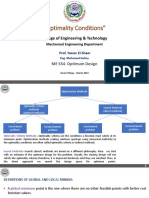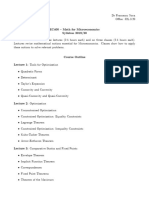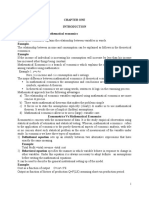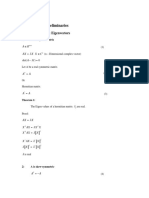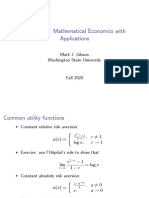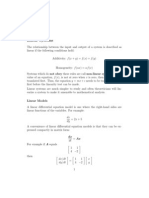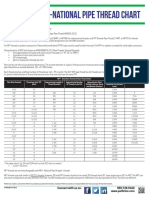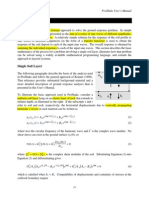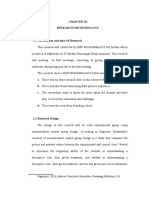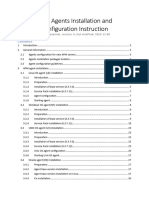Mathematical for Economics
CHAPTER THREE
COMPARATIVE STATIC
3.1 Nature of Comparative Static
Comparative-static analysis, more commonly known as comparative statics, compares the
different equilibrium values of the endogenous variables resulting from changes in the values of
the exogenous variables and parameters in the model. A comparative static analysis can be either
qualitative or quantitative in nature. It is concerned with the comparison of different equilibrium
states that are associated with different sets of values the parameter and exogenous variables.
3.2 Differentiating systems of equation
The Difference Quotient
When x changes from an initial value xo to a new value (xo + ∆x), the value of the function y = f(x)
changes from f(xo) to f(xo + ∆x). The change in y per unit of change in x can be represented by difference
quotient;
Δy f ( x 0 + Δx )−f ( x 0 )
=
Δx Δx
This quotient which measures the average rate of change of y can be calculated if we know the
initial value of x or xo and magnitude of change in x or ∆x
2
Example 1 ; f ( x )=3 x −4
Solution
f(xo)=3(xo)2-4
f(xo + ∆x) =3 (xo + ∆x)2-4
Δy 3( x 0 + Δx) 2−f ( x 0 )
= −4−( 3 xo−4 )
Δx Δx
= 6 xo + 3∆x
Let xo = 3 ∆x = 4
Then, the average rate of change of y is 6(3) + 3(4) = 30. This means that on the average, as x changes
from 3 to 7 then, y is 30 units per change in x
The central problem of the comparative static analysis, that of finding a rate of change can be
identified with the problem of finding the derivative of some function y =f(x)
2023 Page 1
� Mathematical for Economics
Example 2; F(x) = x3
Solution
F’(x) = 3x2
F’(1)= 3
F’(2)= 12
Change in x from 1 to 2 is resulting change in y from 3 to 12, the change in y is 9 units per unit
change in x
3.3 The Jacobian and Hessian determinants
3.3.1 The Jacobian Determinant
The Jacobian determinant permits testing for functional dependence, both linear and
nonlinear. A Jacobian Determinant J is composed of all the first-order partial derivatives of
a system of equations, arranged in ordered sequence.
Given
y1 =f1(x1, x2, x3)
y2 =f2(x1, x2, x3)
y3 =f3(x1, x2, x3)
∂ y1/x1 ∂ y1/ ∂ x2 ∂ y1/x3
|J|= ∂ y2/x1 ∂ y2/x2 ∂ y2/x2
∂ y3/x1 ∂ y3/x2 ∂ y3/x3
Notice that the elements of each row are the partial derivatives of one function yi with respect to
each of the independent variables x1, x2, x3, and the elements of each column are the partial
derivatives of each of the functions y1, y2, y3 with respect to one of the independent variables xj.
If J = 0, the equations are functionally dependent; if J #0, the equations are functionally
independent.
Example 1
2023 Page 2
� Mathematical for Economics
Use of the Jacobian to test for functional dependence is demonstrated below, given
y 1 =5 x1 +3 x 2
y 2 =25 x 21 +30 x 1 x 2 + 9 x 22
solution
First, take the first-order partial derivatives
∂ y1/x1=5 ∂ y1/ ∂ x2= 3 ∂ y2/x1= 50x1 + 30x2 ∂ y2/x2 = 30x1 + 18x2
Then set up the Jacobian,
5 3
|J|= 50x1 + 30x2 30x1 + 18x2
then evaluate,
J = 5(30x1 + 18x2) - 3(50x1+30x2) =0
Since J =0, there is functional dependence between the equations. In this, the simplest of cases,
(5x1+3x2)2 =25x21 + 30x1x2+9x22
2. Given
y 1 =3 x21 + x 2
y 2 =9 x 41 +6 x 21 ( x 2 + 4 )+ x 2 ( x2 +8 )+12
If we partially differentiate these two functions, we get
∂ y1 ∂ y1
=6 x 1 =1
∂ x1 , ∂ x2
∂ y2 ∂ y2
=36 x 31 +12 x 1 x 2 + 48 x1 =6 x21 +2 x 2 + 8
∂ x1 , ∂ x2
Putting these partial derivatives in the form of Jacobian matrix
2023 Page 3
� Mathematical for Economics
J=
[ 36 3
6 x1
x1 +12 x 1 x 2 + 48 x1
1
6 x 21 +2 x 2 +8 ]
And its determinant is
6x1 1
|J|= 3
36x1 + 12x1 x2 +48x1
2
6x1 + 2x2 + 8
3 3
= 36x1 + 12x1 x2 +48x1 - (36x1 + 12x1 x2 +48x1 )
|J|= 0
Therefore, these two functions are dependent of each other. As a result, there is no unique
solution for the system of equations.
3.3.2 The Hessian determinant
Given that the first-order conditions zx =zy = 0 are met, a sufficient condition for a multivariable
function z = f(x, y) to be at an optimum is
1) zxx, zyy > 0 for a minimum
zxx, zyy < 0 for a maximum
2) zxxzyy > (zxy)2
The Hessian H is a determinant composed of all the second-order partial derivatives, with the
second-order direct partials on the principal diagonal and the second-order cross partials off the
principal diagonal. Thus,
|H|= zxx zxy
z yx z yy
where z xy = z yx.
If the first element on the principal diagonal, the first principal minor, |H 1|=zxx is positive and
the determinant is
|H|= zxx zxy
zyx zyy >0
the second-order conditions for a minimum are met.
2023 Page 4
� Mathematical for Economics
When H1 > 0 and H2 >0, the Hessian H is called positive definite. A positive definite Hessian
fulfills the second-order conditions for a minimum.
If the first principal minor H1 = Zxx < 0 and the determinant of
|H|= zxx zxy
zyx zyy >0
ZxxZyy_ (Zxy)2 SOC
the second-order conditions for a maximum are met. When H1 _0, H2 _0, the Hessian H is
negative definite. A negative definite Hessian fulfills the second-order conditions for a
maximum.
Example
Z= 3x2 - xy + 2y2 -4x-7y +12
Solution
Zx = 6x – y - 4 Zxx=6
Zy = -x + 4y -7 Zyy= 2
Zxy= -1 Zyx=-1
|H|= 6 -1
-1 4
6(4) – (-1)(-1) = 23 > 0 minimum condition satisfied
3.4 Comparative static of general function models
There are three variables in this model as it is a one commodity model. These are:
1. quantity demanded of a good (
Qd )
Q
2. quantity supplied of a good ( s )
3. price of a good ( P)
market equilibrium will be achieved when quantity demanded is equal to quantity supplied, i.e.
when the market is cleared
The model includes one equilibrium condition and two behavioral equations.
Algebraically, the model can be expressed as
Q d =Qs
2023 Page 5
� Mathematical for Economics
Qd =α 1 −β 1 P (α 1, β 1¿ 0) ---------------------------- (1)
Q s=−α 2 + β2 P (α 2 , β2 >0)
All of the four parameters α 1, α 2, β 1 , and β 2 are supposed to be positive. Equating Qd and Q s
results in
Qd = Q s = Q
And the model can be written as a reduced form of two equations in two variables:
Q=α 1 −β 1 P
Q=−α 2 + β 2 P ----------------------------------------------- (2)
The model can be further reduced to a single equation in a single variable as
α 1− β1 P=−α 2 + β 2 P
Rearranging this equation gives us
α 1 +α 2 =β 1 P+ β2 P
α 1 +α 2 =P( β 1 + β 2 )
Dividing both sides of the equation by ( β 1 + β 2) gives us the solution value of P, i.e. P .
α 1 +α 2
P̄=
β 1 + β 2 , β 1 + β 2 ≠0 -------------------------------- (3)
Equation 3 indicates the fact that the determinate value, i.e., equilibrium price, is expressed in
terms of the parameters. P is positive because we put the restriction that all the four parameters
are positive.
To get the equilibrium quantity of the market which corresponds to P we should substitute
equation (3) in to one of the equations of equation (2). Substituting it in the supply equation
gives us
α 1 +α 2
−α 2 + β 2 ( )
Q= β 1+ β 2
α1 β 2+ α2 β 2
Q = −α 2 + β 1 + β2
2023 Page 6
� Mathematical for Economics
−α 2 ( β 1 + β 2 )+( α 1 β 2 +α 2 β 2 )
Q= β 1+ β 2
−α 2 β1 −α 2 β 2 +α 1 β 2 +α 2 β 2
= β1 + β 2
α 1 β 2 −α 2 β 1
Q = β1 + β 2 , β 1 + β 2 ≠0 ------------------------ (4)
Similarly, in equation (4) we have observed that equilibrium quantity is expressed in terms of the
parameters. We know that quantity never be negative. Thus, this situation requires that the
numerator (α 1 β 2−α 2 β 1 ) should be positive. This meansα 1 β 2 > α 2 β 1 .
Dear learner! Now we can observe the effect of a small change in one of the parameters either
on P̄ or Q. To do this, we must partially differentiate each variable with respect to each of the
parameters. Through observing the sign of the partial derivative of the variables, for example P ,
with respect to the parameters, we can point out the direction in which P̄ will move when the
parameter changes. If the magnitude is known, it will constitute quantitative analysis. Let us see
the effect of change in the parameters on P ,
∂P 1
∂α 1 = ( β 1 + β 2 )
∂ P̄ 0( β 1 + β 2 )−1( α 1 +α 2 )
∂ β1 = ( β 1 + β 2 )2
−( α 1 +α 2 )
2
= ( β 1 + β 2 ) ----------------------Quotient rule)
∂P 1
=
∂ α 2 β1 + β 2
∂ P̄ ∂ P̄ −( α 1 +α 2 )
∂ β 2 = ∂ β 1 = ( β 1 + β 2 )2
We have put a restriction that all parameters are positive in this model. As a result, we have the
ability to conclude that
2023 Page 7
� Mathematical for Economics
∂P ∂P
>0
∂α 1 = ∂ α 2
It indicates that as the parameter α 1 increases, there will be an upward shift in the demand curve
which leads to an increase in equilibrium price, i.e. p , given the supply curve. However, the
∂P
>0
slope of the demand curve is the same. Similarly, ∂ α 2 shows that an increase in the
parameter α 2 leads to a parallel downward shift in the supply curve which in turn results in an
increase in equilibrium price, i.e. p given the demand curve. In this case, the slope of the supply
curve is constant.
Examples
Given the demand function
Qd = 24 -2p
The supply function
Qs - 5 + 7 P
=
A, find the equilibrium price and equilibrium quantity of the commodity. In our example α 1 = 24,
α 2 =5 , β 1 =2 and β 2 =7 . Equilibrium is achieved where quantity demanded is equal to
quantity supplied of a commodity, i.e.
Q d = Qs = Q
Therefore, at the point of equilibrium
24- 2p= -5 + 7p
24+5 = 7p+2p
29=9p
29
p=
9
P̄ represents the equilibrium price (market price) of the commodity. Substituting the value of
equilibrium price either in the demand or the supply equation gives us the equilibrium quantity.
When we substitute it in the demand equation
29
2( )
Q = 24- 9
2023 Page 8
� Mathematical for Economics
58
Q̄=24−
9
216−58
Q̄=
9
158
Q̄=
9
B, what happens to the equilibrium price P when α 1 increases from 24 to 25 other things being
equal?
It becomes 25-2p = -5+7p
25+5 = 9p
30= 9p
30
p = 9
29 30
The equilibrium price increases from 9 to 9 when the parameter α 1 increases from 24 to 25
units.
C, what happens to the equilibrium price, P when the parameter β 2 increases from 7 to 8?
Please, try to observe the effect of change in the remaining parameters on equilibrium price and
equilibrium quantity of the commodity.
2. Given
Q d = 51 - 3 P
Q s= 6P - 10
Find equilibrium price and quantity of the commodity
3.5 limitation of comparative Static analysis
Comparative statics is a useful area of study, because in economics we are often interested in
finding out how a disequilibrating change in a parameter will affect the equilibrium state of a
model. it is important to realize, however, that by its very nature comparative statics ignores the
process of adjustment from the old equilibrium to the new and also neglects the length of time
required in that adjustment process.
2023 Page 9















